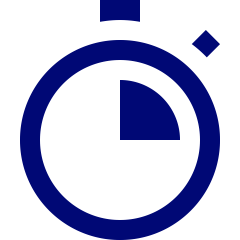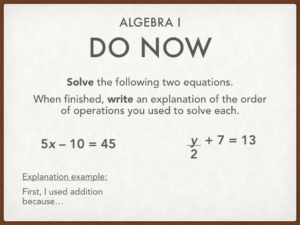How to Do the Do-Now
In middle and high school classrooms, the “Do Now” is ubiquitous. It is a necessary element of the lesson, with a dual purpose: 1) it gives students something to do during the start-of-class transition, and 2) it prepares them for the upcoming lesson.
Too often, the Do Now falls into some predictable traps:
The task takes students too long, and it becomes the Do Forever…
The directions aren’t clear, and it becomes the Do Wha?
It’s not posted when students arrive, and it becomes the Do dee do (the sound students make while twiddling their thumbs waiting for directions)
To get the most out of the Do Now—and to structure it in a helpful, predictable way for students with ASD—it’s best to make it:
Short – Active – Ready – Relevant
Short
The Do Now should only take between 3 and 5 minutes. Any longer, and it cuts into valuable teaching time. Provide students with a task that gets them ready for the upcoming lesson, but doesn’t bleed into the lesson—there will be more opportunities for independent work later in the period.
Do this: Usually have a Do Now that takes longer? Identify a short 3- to 5-minute chunk of the task that students can complete as the Do Now, and find a place in your lesson to continue or expand on it.
Active
The Do Now should require students to do something active, and directions should state concretely what is is they should do. A Do Now like, “What were the primary causes of the American Revolution” doesn’t communicate to students that they should do anything, besides sit there and think. Always start the directions with a verb, and consider what you want to see students doing for these first 3–5 minutes.
Do this: Brainstorm a list of a half dozen verbs that you will use to start the directions of every Do Now. Some good possibilities: write, complete, annotate, solve, jot, etc. For autistic students, the more concrete we can be with directions, the easier the directions are to follow.
Ready
The Do Now should be prepared and posted before students enter. Students should always know where to look to figure out what to do the second they step foot into the classroom. The Do Now also shouldn’t require an explanation—you want them to Do… NOW! The teaching comes later, when the lesson begins.
Do this: Post the directions for your Do Now in the same place every day. This could be on the chalkboard, whiteboard, projected on an interactive whiteboard, or even on a sheet of paper they pick up as they enter—so long as it’s always the same. This predictability is helpful for all students, particularly those on the autism spectrum.
Relevant
The Do Now should be connected to the content you’re teaching. It can either be a preview or a review. A preview prepares them for what they’ll be learning in the upcoming lesson, such as a reading about a historical topic that they’ll be debating. A review helps them practice something from the previous day’s lesson or homework. This can be good for math classes, to give students another opportunity to try their hand at a recent algorithm a couple more times. Since the Do Now should be quick and doable without directions, be careful not to present brand new, potentially challenging material in the Do Now—this may cause unhelpful frustration or anxiety right at the start of the period.
Do this: Decide for each lesson, what is the best way to link to what we’re doing today? Is it more helpful to review something we did yesterday, or preview something we’ll be discussing next?
So, do this… Now!
Make your Do Now:
Short. Plan it taking no more than 3–5 minutes.
Active. Tell students what to do, starting directions with a verb.
Ready. Have it posted when students enter, in the same place every day.
Relevant. Connect the task to the previous or upcoming lesson.
For more about the Do Now, see this post from Teach Like a Champion.
Originally published by Aaron on the Nest Egg blog at the ASD Nest Support Project







